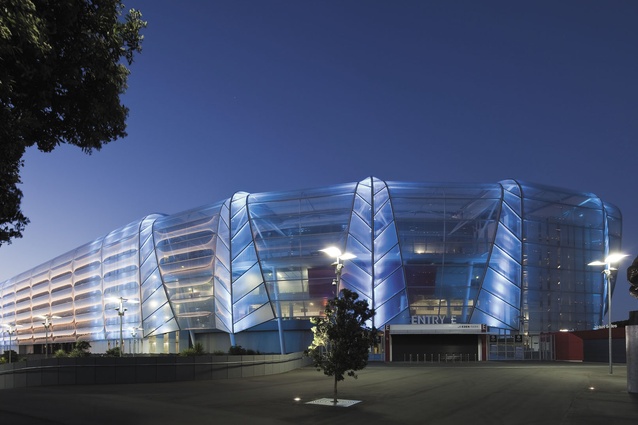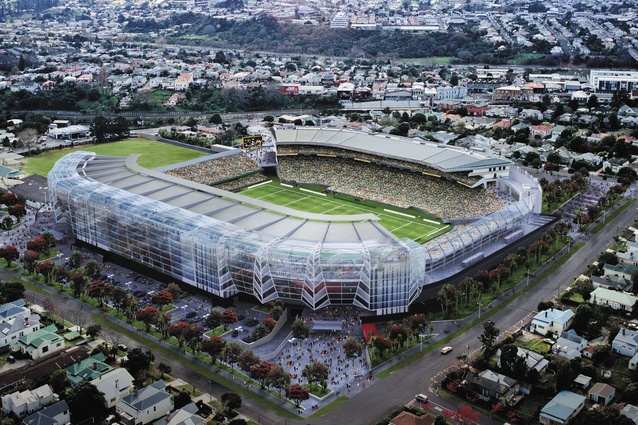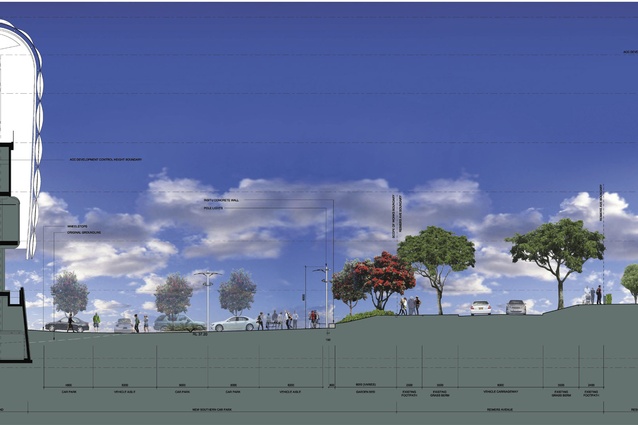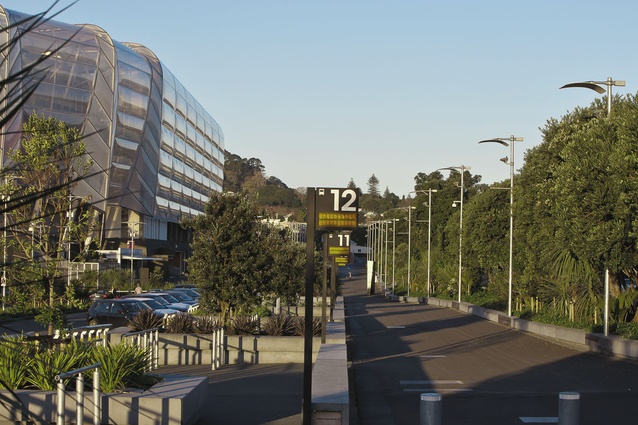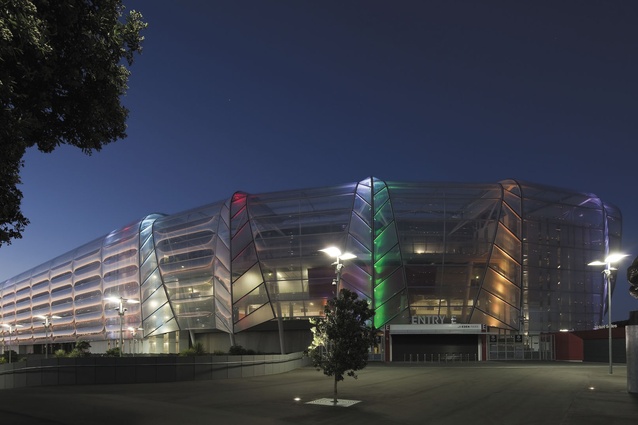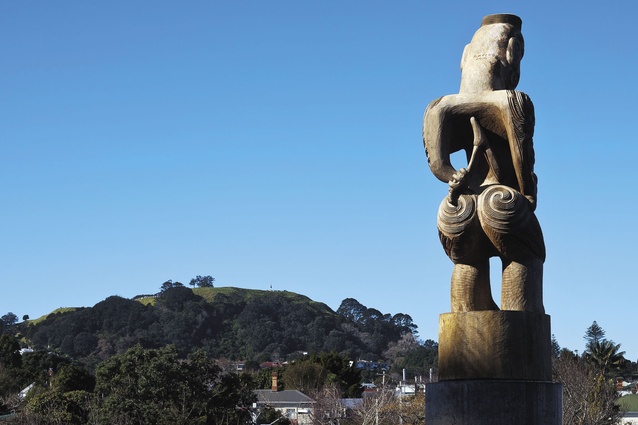Jasmax fills in some of the gaps around its Eden Park project with Populous
Matthew Glubb, Mike Thomas and Joseph Muir sit down and answer some questions about the redevelopment process.
The final whistle may have blown on the Rugby World Cup, but the legacy lives on in the form of this suburban stadium. Opinion is most likely still split over whether the revised Mt Eden stadium was a better option than a new waterfront stadium, but what we do know for sure is that Populous and Jasmax, the designers at Eden Park, have managed to give a little space back to the community by pulling back the stadium’s secure perimeter from the street to the entrance point.
So – when was the start of the project?
Populous, with Jasmax, was engaged in 2005 to provide architecture, urban design and landscape design for Eden Park. One of the most interesting things about the landscape component is that because the whole stadium acts as one integrated system, the landscape, stadium concourses and surrounding streets work all interact quite closely.
Overall, what do you think defines a successful stadium landscape?
Firstly, circulation, functionality and key activities being defined and coordinated from the outset; secondly, responsiveness and sensitivity to landscape context and neighbourhood; thirdly, offering something back to the surrounding community outside of game time, and to provide an aesthetically appealing stadium and opening up the site for community use and enjoyment where possible. Flexibility of use outside of major event times – as much as is achievable – is important.
Are there any stadiums that exemplify how this type of design should be delivered?
Drawing on the international expertise of Populous, and to ascertain best practice for each area of the stadium, benchmarking was carried out on stadiums around the world. Similar stadiums in Australia were visited and Suncorp, in Brisbane, was a good example for us, as it also sits in a sensitive residential environment and dealt with similar issues as Eden Park. Suncorp’s redevelopment improved the physical relationship with its surroundings. This also led to a regeneration of local retail areas, which, in turn, helped change the resident’s perception of the stadium. The residents became some of the stadium’s biggest supporters and the stadium became a positive part of the wider environment – a good neighbour.
How were responsibilities allocated and, in particular, what was the role of the landscape architect?
That role wasn’t confined to the perimeter, or to the planting design either. The approach was multidisciplinary. We worked with Populous and the other consultants to design and coordinate the site works. Our in-house site works design team was comprised of a number of landscape architects, architects, technicians and urban designers. It was important that the architecture and landscape were speaking the same language conceptually, functionally and aesthetically. If we’d separated out the design process based on disciplines this would have been difficult to achieve.
What was the over arching brief?
Overall, the aim was to create a modern, multi-use stadium that provided 60,000 seats for the Rugby World Cup and a legacy capacity of 52,000. The concept design also aimed to improve the amenity of the facility to the local community while creating a modern sporting venue for Auckland and New Zealand. The design and the associated masterplan developed the theme of ‘bringing the park back to Eden Park’ – defining the stadium as a pavilion within a revitalised urban park. The barriers that once separated the stadium from its surroundings were removed and replaced with open plazas containing native flora.
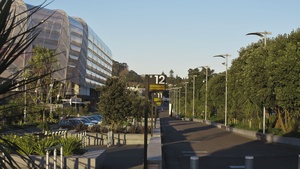
And that was a part of the landscape brief?
The landscape concept revolved around referencing the opportunistic flora of Mt Eden – pohutukawa trees surround the base of the stadium to unify the site and provide a transition in scale between the stadium and its neighbours. The lower planes of the site reference the geology of the area – prior to its sporting and recreational uses, Eden Park was known as ‘Cabbage Tree Swamp’ due to the presence of underground aquifers that link Maungawhau with Western Springs. We expressed this through clustered cabbage tree plantings in groves amongst the Pohutukawa. In a similar manner the iconic nikau palm is also planted throughout the site.
This stadium is located in a residential neighborhood. How do you attempt to blend in – or is that impossible?
The transition in scale from the stadium to the character-filled residential streets was of critical importance. This is probably best illustrated along Reimers Avenue, located to the south of the site. Generally, the role of the vegetation in this instance is not intended to act as screening, but to facilitate a transition in scale from the residential properties across the road, building up towards the stadium. The vegetated buffer that runs along Reimers Ave doesn’t attempt to fully screen the stadium. It aims to provide an informal ‘colonnaded arbour’ effect at pedestrian level, with the filtered views from the public footpath through to the park revealing a layered banding of blocks of vegetation and trees within the park. A solid screen of vegetation would have countered the intention of opening up the boundaries of the site. The canopies of the retained pohutukawa trees do obscure portions of the mid-section of the south stand and, eventually, the newly planted trees will do the same, which helps to break down its scale. Above the canopy of the trees, the use of transparent ETFE cladding partially blends the top of the south stand’s canopy into the sky. This helps minimise the perception of the change in scale. The ETFE cladding also lets light through the top section of the stadium structure reducing the effects of shadowing to the grounds. By moving the stadium security zone right back from the boundaries, there is a large amount of open space available for local community use. The barriers that previously separated the stadium from its surroundings have been removed and replaced with open plazas and extensive areas of native planting. Unsightly solid boundary fences and barriers have been removed, wherever possible, or made visually permeable, for example along Sandringham Road.
How are the spaces arranged?
It’s quite different to working with a ‘clean slate’. Some of the existing spatial arrangements were a given, for example, the position of the stadium and pitch were set. Over the course of the design process, other existing relationships became fixed or worked in with the design requirements for the site, including the No. 2 ground, the high performance centre, the old Members’ Stand and the existing partial framework of semi-mature pohutukawa trees bounding the site. The park must accommodate overlapping programmes and modes of use, so circulation design was a key issue. The demands of both pedestrians and vehicles are space-intensive when we are talking about a full-house crowd and, as you can imagine, their tentacles reach much farther afield than the site boundaries. The site circulation and internal stadium circulation are inseparable and respond as directly as possible to these demands.
How do you plan for different situations, to ensure you have enough space?
During the design phase the stadium and site layouts were tested by pedestrian modelers and the layouts were then tweaked to optimise their performance under the crowd egress conditions. Maximising accessibility throughout the park was of great importance – bold, direct connections and clear legibility of the pedestrian routes were paramount and as such, the main entries occur on each of the four corners of the stadium. Generous, open entry plazas characterise these gathering spaces. Consolidating vegetated zones and using them to ‘embrace’ the entry plazas offers a sense of containment to these spaces, while keeping the spaces themselves relatively clutter-free to contend with the crowds. Outside of event times they make for perfect areas for the neighbourhood kids to come and learn how to skate or ride bikes. The car parking circulation aisles have been opened up to pedestrians to link these plazas east to west within the park. During peak crowd times the aisles are not being used by vehicles, so overlapping these programmes is an efficient use of the space. It enabled us to reduce the overall area of hard pavement and to achieve a generous vegetated visual filter to the south of the site along Reimers Ave. By gently grading this vegetated buffer down towards the stadium and having a low seating wall defining its internal edge, a degree of level separation is provided to its relationship with Reimers Ave, without completely severing it.
Those interested in examining the intricacies of stadia design can read Stadia: A Design and Development Guide online at: http://scr.bi/y63Hl1
Client: Eden Park Redevelopment Board
Architecture/Urban Design: Populous
Landscape Architect: Jasmax

